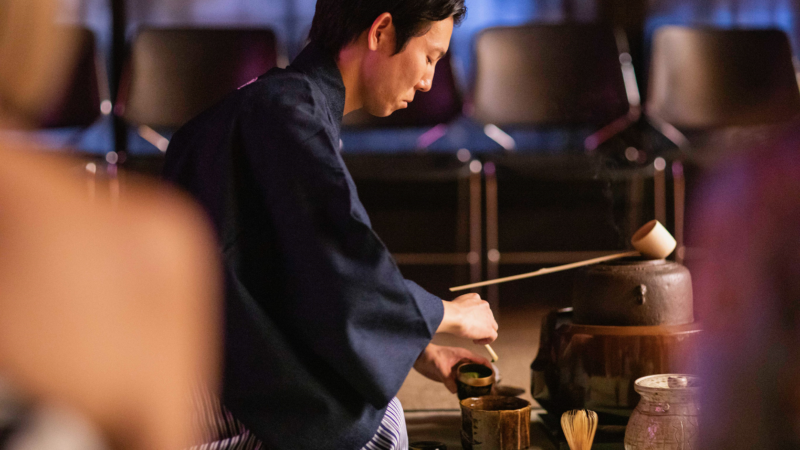
I remember that this was during a time that I was talking with a lot of filmmakers, and I had a meeting with one of them at RESOBOX. I don’t know why it hadn’t occurred to me earlier, but at that moment, the idea sprung up to bring a film festival of Japanese short films to RESOBOX. And so the idea was born.
In fact, I had an inkling of the idea for a long time before. The two films which bookend the first RESOBOX Japanese Short Film Festival are by two filmmakers that gave me the idea a some time ago. The idea that came to me is that there are so many short films either by Japanese filmmakers, or about Japan, yet few viewers are seeing these distinct visions. The thing about short films is that they are often created by independent film makers who are trying to express their unique viewpoints. (Such unique viewpoints are not frequently seen in mainstream films due to the fact that they cost millions of dollars to make; when someone invests so much money, they are less likely to allow filmmakers to express unique visions for fear of not making their money back.)
And so I decided that the mission of the RESOBOX Japanese Film Festival could be summed up easily: we want to show a unique side of Japan or Japanese ideas that are different from the mainstream cinema. We wanted the notion of Japan to be broad so that we could show what different people around the world might think about the idea of “Japan” or “Japanese.” What is Japan? What is Japanese? Sometimes asking questions about the most obvious ideas brings more interesting and diverse responses than might be expected. How would you answer these seemingly easy questions? Well, we found several filmmakers from around the world to try to explore these ideas.
One thing that I love about independent filmmakers is that, not only do they have unique visions, but they also make the change that they want to see. In the early 21st century, filmmaking resources are more open and available than they’ve ever been. And so I hope that people everywhere are encouraged to go out there, and change the world with films!

Japan’s Disposable Workers by Shiho Fukada
Upon first watching this set of films, I immediately recognized that there was a side of Japan that I had never before considered. While I fell in love with an imaginary, fantastic Japan of anime, manga, and “CoolJapan,” there was something that I felt I was missing about the real world, about real life, and how social and economic development have passed. Feeling that more people need to see this film about a dark aspect of Japan, this is one of the films that spurred me to bring this festival together.
Line & Dot by Shaqayeq Valipour
From Iran, this film is an example of the spread and scope of Japanese culture around the world. Living under a regime that she calls repressive against women, Ms. Valipour has nonetheless been exposed to Japanese art and animation, and is thus able to offer her own interpretation of what she has referred to as the simplistic and elegant design of Japan.
Now What? by Anna G. Jones
In this film we immediately see the kinds of faces that aren’t frequently portrayed on the screen, and the difficulties of portraying such faces on the screen. This reminds me of the recent controversy over casting Scarlett Johanson in the upcoming live-action version of Ghost in the Shell (or Matt Damon in a film about ancient China). Further beneath this exploration of identity, and the difficulty of such definitions, this film reminds us of the souls behind faces we might overlook everyday, and why we need to see more of them in movies.
Akutagawa’s Rashomon by George Tsouris
It seems to me, wandering around New York Comic Con recently, that there are quite a few panels aimed towards folks who want to break into Japanese animation, typically as English voice-over stars, or something like that. With the emergence the American Michael Arias, who made one of my favorite anime films, Tekkon Kinkreet, we might ask what it means when a someone who isn’t Japanese makes a Japanese film. So I tried to make my own Japanese animated film, and see what that might mean.
A Big Hand of a Japanese Cedar Tree by Usami Yoshiko
One thing that amazes some people about Japan is how the traditional and the modern are side-by-side in Japanese society. (I’m not sure I buy this, but some people say it.) In this film, we start seeing how old traditions are still being exercised by folks. But then real world problems, like illness, disease, and disability come in, and we learn how addressing these issues is evolving in Japan.
Onigiri-Kun by Ippei Kurahashi
This film explores a different side of the ever-present Japanese convenience store, from the perspective of the solitary worker. His challenges as he searches for love, meaning, purpose and magic, are dreamed in this surreal fantasy.
One-Two-One-Seven by Brett Kodama
This film explores a dark side of American history during World War II, and how it treated Japanese-Americans during their forced internment. This documentary gives a voice to one who experienced Japanese Relocation as a child, and the difficulties of trying to make sense, both then and now. Who gets to define what Japanese means, and what names to give?
oiL by Shihei Nishizawa
One of the key reasons that I put this festival together is because I wanted to offer a different notion of what we might understand as “Japanese animation.” It seems to me that many people get a first impression of Japanese via anime. The curious thing there is that the dominant visual style in these works, while not monolithic, does feature a very strong tradition that is adhered to in many anime we see. I wanted to include animated films here that challenge this visual understanding of animation in Japan. Indeed, there are many animators in Japan who are pushing against these traditional boundaries, and I think you’ll see that here.
Himitsu by Steve Gee
While Japan is traditionally viewed as a homogenous culture (typically in terms of race and class status), recent years have seen an upsurge of people, artists, and filmmakers recognizing and representing the rich diversity that exists within Japan. This film shows us that there are many different ways that Japanese live, in terms of family structure, bodily shape, gender roles, and others. It asks how we come to terms with our differences.
Mt. Head and Parade de Satie by Koji Yamamura
This final filmmaker inspired me to share so many diverse visions of what “Japanese” and “Japanese cinema” mean. When I first learned about Koji Yamamura, he was the first independent Japanese animator I had been exposed to. And indeed, his visual style is quite independent from the typical anime stylings. With his 2002 Academy Award Oscar Nominated film, Mt. Head, he shows us that beyond these traditional boundaries, there are other valuable traditions and stylistic choices, yet other difficulties emerge when thinking outside the box.





